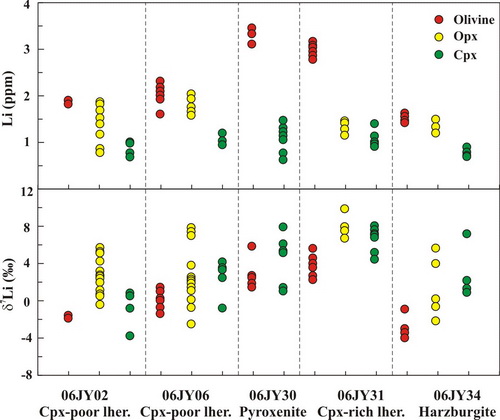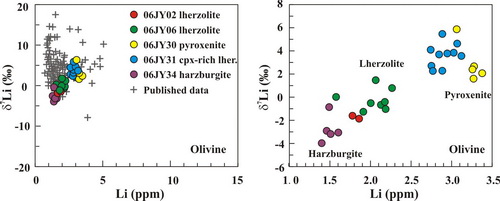In-situ lithium (Li) concentrations and δ7Li of olivine, orthopyroxene (opx) and clinopyroxene (cpx) in mantle xenoliths from the Quaternary Longgang maar provide insights into the nature and evolution of the lithospheric mantle beneath the easterly part of the North China Craton. SIMS analyses show Li partitioning of olivine>opx≥cpx and Li isotopic disequilibrium in each sample. Olivines in harzburgite are generally homogeneous, with Li abundances in the range of normal mantle, but their δ7Li (−0.9 to −4.0) are lower than normal mantle olivine δ7Li values of ~+4±2. Olivines in cpx-rich lherzolite and pyroxenite have higher Li contents and normal mantle-like δ7Li values. The olivine δ7Li values in the harzburgite and cpx-poor lherzolites are much lower than those published for worldwide peridotites, showing the peculiarity of these peridotites.
The Li abundances and δ7Li in the olivines show a positive correlation, indicating mixing between a low-δ7Li melt and normal mantle. Collectively, Li elemental and isotopic compositions of the xenoliths suggest that low δ7Li in olivines reflect a slab-derived Li isotopic signature in the lithospheric mantle. These observations, coupled with geochemical and geophysical evidence, suggest that the lithospheric mantle has been modified three times by (1) low-δ7Li melt likely derived from the subducted Pacific plate (leading to the low δ7Li of olivines), (2) high-degree partial melting (decreasing Li abundances of harzburgite and cpx-poor lherzolites close to the normal mantle), and (3) refertilization by melts mainly from the asthenosphere (producing the normal mantle-like δ7Li and high Li contents in cpx-rich lherzolite and pyroxenite). The melts/fluids derived from the subducted Pacific plate could play a crucial role in the destruction of the craton.

Fig. 1 Li abundances and δ7Li in the minerals of mantle xenoliths

Fig.2 Variation of Li abundances and δ7Li of olivines in the mantle xenoliths
Tang et al. Slab-derived lithium isotopic signatures in mantle xenoliths from northeastern North China Craton.
Lithos, 2012, 149, 79-90 (
Download Here)